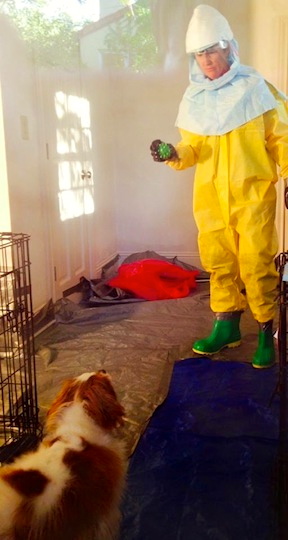
Photo courtesy of Dallas Animal Services
Dr. Deb Zoran played ball with Bentley twice a day. As one of the few people who had direct contact with the dog during his three-week quarantine, Zoran did her best to ease his isolation. “I wanted to spend enough time with him each time we were in there that he had some sense of connectedness,” she said.
During the 16 days that they tended the world’s first dog to be quarantined for possible Ebola, Drs. Deb Zoran and Wesley Bissett felt the highest stress while awaiting results of the pet’s initial test for the fearsome virus.
It wasn’t their own safety they worried about, but that of the Cavalier King Charles spaniel named Bentley. “If this dog's blood, urine or feces was to come back positive for the virus, the (probable) plan was euthanasia,” Zoran said. "Neither Dr. Bissett nor I favored that path."
Professors at Texas A&M University’s veterinary college and leaders of the university’s Veterinary Emergency Team, Zoran and Bissett would have advocated keeping the pet in a biologically secure facility and studying how the virus manifests in a dog, a subject about which science knows very little.
Beyond their desire for more knowledge, the veterinarians wanted to safeguard the charismatic pup for his owner, a nurse named Nina Pham, who last month became the first person to contract Ebola in the United States.
“We were preparing ourselves to try to argue against … (euthanasia), because that would have been a sad day on many, many, many levels: scientific levels, personal levels, Nina Pham’s level — all kinds of levels,” Zoran said in a telephone interview.
As it turns out, no arguments were necessary. Bentley’s tests came back negative, his owner recovered from the illness and on Nov. 1, they happily reunited. The
joyful ending capped a three-week affair in which everything that could have gone right, did: Bentley stayed healthy, he endured captivity with model behavior, and veterinarians trained to respond to all manner of emergencies were nearby and ready to step up.
Said Zoran, “It’ll never be that easy again.”
They didn’t know how smoothly it would go, of course, when word came to the Veterinary Emergency Team (VET) on Oct. 13 that its services were needed for the first Ebola crisis on American soil.
The nation was on edge. In Dallas, a hospital had mishandled the health evaluation of a sick visitor from Liberia, center of an Ebola outbreak. By the time Thomas Eric Duncan was diagnosed, he was gravely ill and scores of people potentially had been exposed. Duncan died Oct. 8. Pham was one of his nurses. By Oct. 11, Pham had a fever and went to the hospital. She had contracted Ebola and would be isolated for treatment.
At home in Pham’s apartment was Bentley. The 1½-year-old dog’s fate was a subject of intense public attention because just a few days before, a court in Spain ordered the death of a dog belonging to an Ebola patient. Despite a worldwide protest and no evidence that the dog, named Excalibur, was infected, he was euthanized. (His owner eventually recovered from the disease and
reportedly is suing for compensation of some $190,000 for her dog.)
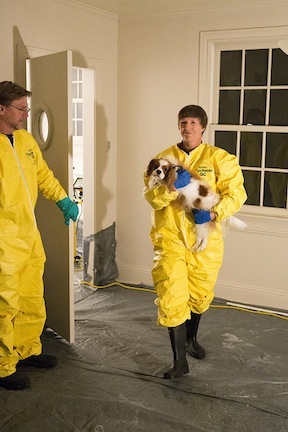
Photo by Larry Wadsworth, Texas A&M University
Dr. Wesley Bissett held the door as Zoran brought out Bentley when the dog's quarantine ended on Nov. 1. The veterinarians wore protective suits for warmth that chilly morning.
City officials in Dallas immediately pledged to take care of Bentley for Pham but exactly how, they weren’t sure. “They were asking for people with experience, expertise and willingness but they didn’t have trained people and didn’t have the resources," Zoran said "That’s when they reached out to the state.”
A variety of veterinarians at Texas A&M University happened to be able and willing to help. The first to respond was Dr. Tammy Beckham, director of the university’s Institute for Infectious Animal Diseases. Coincidentally, Beckham at one time worked with Ebola at the U.S. Army’s Medical Research Institute for Infectious Diseases.
Early on, word spread briefly on campus that Bentley would be taken to the university in College Station, 180 miles south of Dallas. “There was a lot of fear surrounding Bentley; let’s just be honest,” Zoran recounted. “… The rumor mill was that the dog was coming here, and people were going crazy.”
But there were no facilities on campus that could quarantine him. Bentley ended up being sequestered much closer to home, on the grounds of Hensley Field, an inactive military airfield owned by the city of Dallas. Beckham looked after him there until Zoran and Bissett arrived on Oct. 16.
As director and operations chief, respectively, of the 38-member VET, Bissett and Zoran are trained in a spectrum of emergency situations, whether natural disasters, industrial accidents or searching for missing persons. Since it formed in 2009, the team has responded to about a dozen incidents small and large, although none of them like dealing with Ebola.
Among the team’s many attributes is a skill that is key to working around a deadly pathogen: they know how to wear and function in the unwieldy garb known as personal protective equipment. Zoran said it takes practice and teamwork: “Oh my gosh, yes. It is easy to screw up. If you are not being extremely careful every single time you put on or take off the PPE, is easy to skip a step, contaminate a surface, and now what was on your suit is on you.”
Another attribute that suited VET for the job was the number of people available. When using protective garb, it’s best to work in pairs or with a trained observer, Zoran said: Your buddy watches to make sure you put on and take off your gear properly and comes to the rescue if you get in trouble while working in the zone of potential exposure — the so-called hot zone.
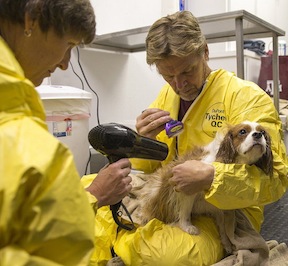
Photo by Larry Wadsworth, Texas A&M University
After giving him a bath, Zoran and Bissett dried and brushed Bentley in preparation for the reunion with his owner and a press conference.
As a small animal veterinarian, Zoran took the job of working directly with Bentley in the hot zone — in this case, the kitchen of a 1920s-era house that was once home to military officers. Bissett, a mixed animal veterinarian, mostly stayed next door in the dining room, which served as the “warm zone” where the duo donned and doffed protective equipment and where waste from the hot zone was transferred and secured for disposal. Bissett kept an eye on Zoran through a window in the swinging door between the rooms. From outside, Dallas city employees took photographs through a kitchen window to post on Facebook.
Going in the first time, Zoran didn’t know a lot about Bentley except his breed, Cavalier King Charles spaniel, which she knew to be “traditionally calm, couch-potato, loving creatures.” She knew, too, that he was not likely to have been exposed to Ebola-laden body fluids such as vomitus or feces because his owner went to the hospital as soon as she developed a fever.
And she knew that, while one team of
scientists found antibodies to the virus in the blood of dogs exposed during an outbreak in the African nation of Gabon in 2001 and 2002, no one has documented clinical illness in dogs from Ebola, nor evidence that they may transmit it.
Veterinary public health experts tend to believe the risk posed by dogs in Ebola transmission to be very low. But when working with an animal that potentially had contact with the dangerous virus, Zoran said, one must assume the worst and behave accordingly.
“You’re allowed to think that it’s unlikely this dog has this. You’re not allowed to act that way,” she said. “… It was absolutely imperative for us to treat this with the utmost respect.”
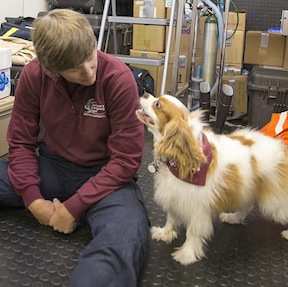
Photo by Larry Wadsworth, Texas A&M University
Zoran and Bentley bonded during their unusual experience. At one point, when Zoran left Bentley with dignitaries who had come to the Veterinary Emergency Team trailer to visit, he barked at the door until she returned. “He got pretty attached to his captor,” Zoran said.
Bentley made it easy. “We thank our lucky stars for Bentley because he was such an incredibly well-trained dog; not hyperactive, not bitey,” Zoran said. “If we’d had a big, old Labrador, we’d have had to use pharmaceuticals to keep him calm.”
Bentley’s training taught him not to relieve himself indoors, which posed a dilemma. “The first few days, he was truly reticent to eliminate,” Zoran recalled. “We started thinking about bringing in those fake grass pads. Eventually, he eliminated in a far corner away from the kennel, and he started figuring out that was his spot. … I got to the point of being able to say, ‘Go pee,’ and he’d go to the corner and do his thing, and I’d clean it up.”
Zoran also figured out that a game of ball helped. “He was not having bowel movements the first couple of days; he was holding it. I was thinking, ‘This dude’s got to go or we will have trouble.’ So I got the ball to get him moving. After a couple of days, he got used to me and the routine. We played ball twice a day. That helped him become a regular guy.”
Paying close attention to his digestive rhythm wasn’t a trivial pursuit. Any hint of poor health could have been a problem for Bentley. Knowing that dogs may develop stomach upset from being boarded or a significant change in routine, Zoran reported with relief, “We managed to dodge stress diarrhea and other health issues for three weeks. (The possibility) really scared the daylights out of me.”
For that reason, she kept Bentley on a stringent diet — his own. Treats that well-wishers sent to show support, though appreciated by his caretakers, never made it into his mouth. “The last thing I want is a dog that has diarrhea from diet change, and now I’m trying to explain that, ‘No, he doesn’t have diarrhea because he’s sick; he’s got diarrhea because people are sending him things,’ ” Zoran said.
The veterinarians monitored their own health, too. Twice a day, they measured their temperatures. Bissett, prone to allergies this time of year, added a little prayer before each reading. “I felt fine throughout, but in all honesty, every time you took your temperature, you were like, ‘I feel great, just be normal,’ ” he said.
To kill any virus that might be lurking on their protective garb, the pair liberally treated everything with bleach. At one point, Zoran said to Bissett, “There’s a greater chance of (getting sick from) Clorox toxicity than having something infectious!”
The risk of an accident went up briefly when Zoran twice drew blood from Bentley for Ebola tests. With Bissett assisting, she managed to handle the needle adeptly through two pairs of gloves, and the dog didn’t wiggle; the tense moments passed without incident.
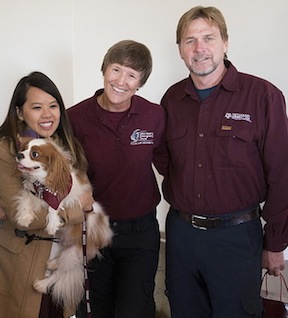
Photo by Larry Wadsworth, Texas A&M University
The reunion drew broad smiles all around. Zoran and Bissett said being able to safeguard Bentley for his owner, Nina Pham, left, was gratifying. “It was definitely an honor to be a part of it,” Bissett said.
For the duration of the assignment, Zoran and Bissett stayed in a hotel eight miles from Hensley Field. They cared for Bentley three times a day between 7 a.m. and 7 p.m. Between visits, they worked out of a VET trailer parked outside the house, participating in meetings with the state or tending university responsibilities by telephone and computer. Bissett in particular had a heavy lecture schedule that he maintained long distance.
Zoran’s and Bissett’s respective spouses took care of things at home so the veterinarians could be away for the better part of three weeks.
Because serving on the VET is part of their jobs as university faculty, the veterinarians received no extra pay for the long deployment, nor did they seek it. Emergency response “is part of what we do. It’s something that we all love doing,” Zoran said.
The VET plans to absorb the cost of their deployment, which amounts to $7,500, not including salaries.
Bissett said he is proud of how Bentley’s situation was handled; that everyone from the state of Texas to the U.S. Centers for Disease Control and Prevention was in accord that the dog should be cared for. “To me, that just says a lot about our country. It says a lot about how much we value our animals,” Bissett said.
Zoran agreed: “One thing for me that was incredibly important was that we did not deal with this like Spain and just have a knee-jerk reaction that ‘this dog has been exposed, therefore we’re not going to deal with this dog; we’re not going to expend the expense or put these resources into the dog.’ To me, that wasn’t the right answer. There’s a human being involved whose life is at risk because of this disease, and every day, the one thing she asked was, how was her dog? … To have treated her dog any differently (from what was done) would have been incredibly disrespectful to that relationship.”
The Bentley experience showed that taking care of a dog in Ebola quarantine is doable, Zoran said. “Obviously, if there were (more) dogs, it would be a different deal, but it could still be managed,” she said.
But the experience yielded no answers on some important questions. It’s still unknown whether dogs can become ill from Ebola or play a part in transmitting the virus. No virus was detected in Bentley’s blood, urine or feces, but it’s unknown whether that’s because he was never exposed or because his immune system suppressed an infection. Zoran said Bentley wasn't tested for antibodies to the virus.
Should another dog in the future be quarantined for Ebola exposure and found to be infected, chances are that science will remain ignorant of the disease’s effects on the species. Interim guidance released last week by a working group of the American Veterinary Medical Association calls for the animal to be euthanized. The guideline applies to cats, as well, a species about which science has no information in the context of Ebola.
One aspect of the guidance is prevention. It recommends avoiding exposure and the prospect of a quarantine by removing any pets from the home of anyone who is being monitored for Ebola. If it’s not possible to send the pet away, the guidelines recommend that the owner avoid contact with the animals and have someone else take care of it in the home.
Zoran echoes that advice. “If you have an Ebola-positive person,” she said, “then the best thing is to have them not interact with animals so you don’t have to quarantine them.”